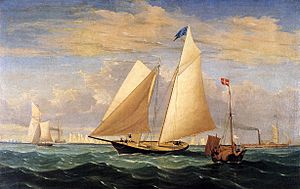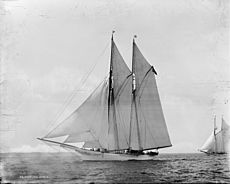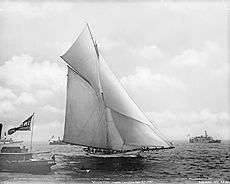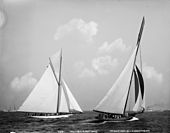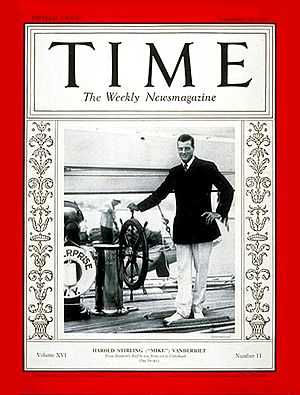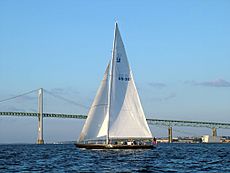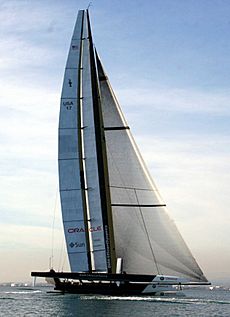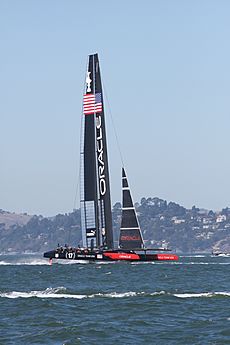America's Cup facts for kids
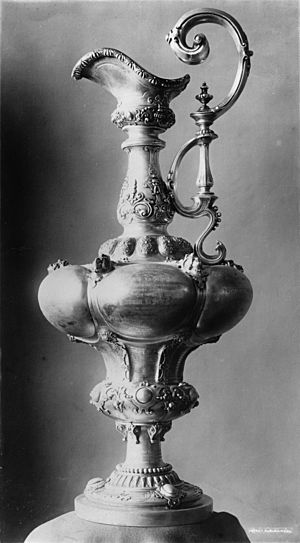
The America’s Cup ewer
|
|
| Sport | Sailing match race |
|---|---|
| Founded | 1851 |
| Most recent champion(s) |
|
| Most titles | |
| Official website | AmericasCup.com |
The America's Cup, affectionately known as the Auld Mug, is a trophy awarded to the winner of the America's Cup match races between two sailing yachts. One yacht, known as the defender, represents the yacht club that currently holds the America's Cup and the second yacht, known as the challenger, represents the yacht club that is challenging for the cup. The timing of each match is determined by an agreement between the defender and the challenger. The America's Cup is the oldest international sporting trophy. It will next be raced for in the southern summer, in March 2021.
The cup was originally awarded in 1851 by the Royal Yacht Squadron for a race around the Isle of Wight in the United Kingdom, which was won by the schooner America. Originally known as the 'R.Y.S. £100 Cup', the trophy was renamed the 'America's Cup' after the yacht and was donated to the New York Yacht Club (NYYC) under the terms of the Deed of Gift, which made the cup available for perpetual international competition.
Any yacht club that meets the requirements specified in the deed of gift has the right to challenge the yacht club that holds the cup. If the challenging club wins the match, it gains stewardship of the cup.
The history and prestige associated with the America's Cup attracts not only the world's top sailors and yacht designers but also the involvement of wealthy entrepreneurs and sponsors. It is a test not only of sailing skill and boat and sail design, but also of fundraising and management skills. Competing for the cup is expensive, with modern teams spending more than $US100 million each; the 2013 winner was estimated to have spent $US300 million on the competition.
The trophy was held by the NYYC from 1857 (when the syndicate that won the cup donated the trophy to the club) until 1983. The NYYC successfully defended the trophy twenty-four times in a row before being defeated by the Royal Perth Yacht Club, represented by the yacht Australia II. The NYYC's reign was the longest winning streak (in terms of date) in the history of all sports.
From the first defence of the cup in 1870 through the twentieth defence in 1967, there was always only one challenger. In 1970, for the first time, there were multiple challengers, so the NYYC agreed that the challengers could run a selection series with the winner becoming the official challenger and competing against the defender in the America's Cup match. Since 1983, Louis Vuitton has sponsored the Louis Vuitton Cup as a prize for the winner of the challenger selection series.
Early matches for the cup were raced between yachts 65–90 ft (20–27 m) on the waterline owned by wealthy sportsmen. This culminated with the J-Class regattas of the 1930s. After World War II and almost twenty years without a challenge, the NYYC made changes to the deed of gift to allow smaller, less expensive 12-metre class yachts to compete; this class was used from 1958 until 1987. It was replaced in 1990 by the International America’s Cup Class which was used until 2007.
After a long legal battle, the 2010 America's Cup was raced in 90 ft (27 m) waterline multihull yachts in a best of three "deed of gift" match in Valencia, Spain. The victorious Golden Gate Yacht Club then elected to race the 2013 America's Cup in AC72 foiling, wing-sail catamarans. Golden Gate Yacht Club successfully defended the cup. The 35th America's Cup match was announced to be sailed in 50 ft foiling catamarans.
The history of the America's Cup has included legal battles and disputes over rule changes including most recently over the rule changes for the 2017 America's Cup.
The America's Cup is currently held by the Royal New Zealand Yacht Squadron, who will stage the 36th defence of the Cup in 2021.
Contents
- History
- 1851: America wins the Cup
- 1870–1881: First challenges
- 1885–1887: The NYYC Rule
- 1889–1903: The Seawanhaka Rule
- 1914–1937: The Universal Rule
- 1956–1987: The Twelve-Metre Rule
- 1988: The Mercury Bay Challenge
- 1992–2007: The IACC rule
- 2010: The Golden Gate Challenge
- 2013–2017: The catamaran rules
- 2021 America's Cup
- Challengers and defenders
- Records of winning clubs and skippers
- In the media
- Images for kids
- See also
History
The Cup is an ornate sterling silver bottomless ewer crafted in 1848 by Garrard & Co. Henry William Paget, 1st Marquess of Anglesey bought one and donated it for the Royal Yacht Squadron's 1851 Annual Regatta around the Isle of Wight.
It was originally known as the "R.Y.S. £100 Cup", standing for a cup of a hundred GB Pounds or "sovereigns" in value. The cup was subsequently mistakenly engraved as the "100 Guinea Cup" by the America syndicate, but was also referred to as the "Queen's Cup" (a guinea is an old monetary unit of one pound and one shilling, now £1.05). Today, the trophy is officially known as the "America's Cup" after the 1851 winning yacht, and is affectionately called the "Auld Mug" by the sailing community. It is inscribed with names of the yachts that competed for it, and has been modified twice by adding matching bases to accommodate more names.
1851: America wins the Cup
In 1851 Commodore John Cox Stevens, a charter member of the fledgling New York Yacht Club (NYYC), formed a six-person syndicate to build a yacht with intention of taking her to England and making some money competing in yachting regattas and match races. The syndicate contracted with pilot boat designer George Steers for a 101 ft (30.78 m) schooner, which was christened America and launched on 3 May 1851.
On 22 August 1851, America raced against 15 yachts of the Royal Yacht Squadron in the Club's annual 53-nautical-mile (98 km) regatta around the Isle of Wight. America won, finishing 8 minutes ahead of the closest rival. Apocryphally, Queen Victoria, who was watching at the finish line, was reported to have asked who was second, the famous answer being: "Ah, Your Majesty, there is no second."
The surviving members of the America syndicate donated the cup via the Deed of Gift of the America's Cup to the NYYC on 8 July 1857, specifying that it be held in trust as a perpetual challenge trophy to promote friendly competition among nations.
1870–1881: First challenges
No challenge to race for the Cup was issued until British railway tycoon James Lloyd Ashbury's topsail schooner Cambria (188 tons, 1868 design) beat the Yankee schooner Sappho (274.4 tons, 1867 design) in the Solent in 1868. This success encouraged the Royal Thames Yacht Club in believing that the cup could be brought back home, and officially placed the first challenge in 1870. Ashbury entered Cambria in the NYYC Queen's Cup race in New York City on 8 August against a fleet of seventeen schooners, with time allowed based on their tonnage. The Cambria only placed eighth, behind the aging America (178.6 tons, 1851) in fourth place and Franklin Osgood's Magic (92.2 tons, 1857) in the fleet's lead.
Trying again, Ashbury offered a best-of-seven match race challenge for October 1871, which the NYYC accepted provided a defending yacht could be chosen on the morning of each race. Ashbury's new yacht Livonia (264 tons) was beaten twice in a row by Osgood's new centreboard schooner Columbia (220 tons), which withdrew in the third race after dismasting. The yacht Sappho then stepped in as defender to win the fourth and fifth races, thereby successfully defending the cup.
The next challenge came from the Royal Canadian Yacht Club and was the first to be disputed between two yachts only. The schooner Madeleine (148.2 tons, 1868), a previous defender from the 1870 fleet race, easily defeated the challenger Countess of Dufferin (221 tons, 1876 design by Alexander Cuthbert). Cuthbert filed the second Canadian challenge, bankrolling, designing and sailing the first sloop challenge for the America's Cup in 1881. The small 65 ft (19.81 m) Canadian challenger Atalanta (84 tons, 1881), representing the Bay of Quinte Yacht Club, suffered from lack of funds, unfinished build and a difficult delivery through the Erie Canal from Lake Ontario to New York. In contrast, the NYYC cautiously prepared its first selection trials. The iron sloop Mischief (79 tons, 1879 design by Archibald Cary Smith) was chosen from four sloop candidates, and successfully defended the cup.
1885–1887: The NYYC Rule
In response to the unsuccessful Canadian challenges, the Deed of Gift was amended in 1881 to require that challenges be accepted only from yacht clubs on the sea. The Deed was further amended to provide that challenger yachts must sail to the venue on their own hull. Furthermore, Archibald Cary Smith and the NYYC committee devised a new rating rule that would govern the next races. They included sail area and waterline length into the handicap, with penalties on waterlines longer than 85 ft (25.91 m). Irish yacht designer John Beavor-Webb launched the challengers Genesta (1884) and Galatea (1885), which would define the British "plank-on-edge" design of a heavy, deep and narrow-keel hull, making for very stiff yachts ideal for the British breeze. The boats came to New York in 1885 and 1886 respectively, but neither would best the sloops Puritan or Mayflower, whose success in selection trials against many other candidates proved Boston designer Edward Burgess was the master of the "compromise sloop" (lightweight, wide and shallow hull with centerboard). This design paradigm proved ideal for the light Yankee airs.
In 1887, Edward Burgess repeated his success with the Volunteer against Scottish yacht designer George Lennox Watson's challenger Thistle, which was built in secret. Even when the Thistle was drydocked in New York before the races, her hull was draped to protect the secret of her lines, which borrowed from American design. Both Volunteer and Thistle were completely unfurnished below decks to save weight.
1889–1903: The Seawanhaka Rule
In 1887, the NYYC adopted the Seawanhaka Corinthian Yacht Club's rating rule, in which Bristol, RI naval architect Nathanael Herreshoff found loopholes that he would use to make dramatic improvements in yacht design and to shape the America's Cup's largest and most extreme contenders. Both Herreshoff and Watson proceeded to merge Yankee sloop design and British cutter design to make very deep S-shape fin-keeled hulls. Using steel, tobin bronze, aluminium, and even nickel for novel construction, they significantly lengthened bow and stern overhangs, further extending the sailing waterline as their boats heeled over, thus increasing their hull speed.
The next America's Cup challenge was initially limited to 70 ft (21.34 m) waterline in 1889, but the mutual-agreement clauses of a new 1887 Deed of Gift caused the Royal Yacht Squadron to withdraw the Earl of Dunraven's promising Watson designed challenger Valkyrie while she was crossing the Atlantic. Dunraven challenged again in 1893, pleading for a return to the longer 85 ft (26 m) limit. In a cup-crazed Britain, its four largest cutters ever were being built, including Watson's Valkyrie II for Dunraven's challenge. Meanwhile, the NYYC's wealthiest members ordered two cup candidates from Herreshoff, and two more from Boston yacht designers. Charles Oliver Iselin, who was running the syndicate behind one of the Herreshoff designs called Vigilant, gave the naval architect leave to design the yacht entirely as he willed. Herreshoff helmed Vigilant himself and beat all his rivals in selection trials, and defended the cup successfully from Valkyrie II.
Urged to challenge again in yet larger boat sizes, Dunraven challenged again in 1895 with a 90 ft (27.43 m) waterline limit. The Watson designed challenger Valkyrie III received many innovations: She would be wider than the defender, and featured the first steel mast. The NYYC ordered another defender from Herreshoff, which he had built in a closed off hangar and launched at night so as to conceal her construction: Defender used an aluminium topside riveted to steel frames and manganese bronze below waters. This saved 17 tons of displacement, but later subjected the boat to extreme electrolysis after the Cup races. Valkyrie III lost the first race, was deemed disqualified in the second race following a collision with Defender before the start line despite finishing first, and in turn withdrew from the contest. The unraveling of the races left Dunraven in a bitter disagreement with all parties over fairness of the cup committee concerning claims. After he asserted that he had been cheated, his honorary membership of the NYYC was revoked. Henry "Hank" Coleman Haff, was inducted into America's Cup Hall of Fame in 2004 for his sailing of Defender in 1895 and bringing the cup back. At age 58, Hank Haff was the oldest cup winner in the history of the race.
The climate was estranged until Scottish businessman Sir Thomas Lipton became the financial backer for the Royal Ulster Yacht Club's 1899 challenge. William Fife was chosen to design the challenging yacht because of past success in American waters. The yachts increased yet again in size, and this time Herreshoff fitted a telescopic steel mast to his defender Columbia, but his largest contribution was to recruit Scottish-American skipper Charlie Barr. The latter had helmed Fife designs in Yankee waters before, and he had shown perfect coordination with his hand-picked Scandinavian crew. Barr successfully helmed Columbia to victory, and Lipton's noted fair play provided unprecedented popular appeal to the sport and to his tea brand.
Although upset with the Shamrock, Lipton challenged again in 1901, turning this time to George Lennox Watson for a "cup-lifter": Shamrock II, Watson's fourth and final challenger, was the first cup contender to be thoroughly tank-tested. To defend the Cup, businessman Thomas W. Lawson funded for Boston designer Bowdoin B. Crowninshield a daring project: his yacht Independence was capable of unrivaled performance because of her extremely long sailing waterline, but she was largely overpowered and unbalanced and suffered from structural issues. Furthermore, Lawson's failure to commit to the NYYC's terms for defending the Cup defaulted the Independenceʼs elimination. Herreshoff had again received a commission from the NYYC, but had failed to secure Charlie Barr to skipper his new yacht Constitution. Instead, the Columbiaʼs syndicate kept Barr's crew and tried another defense. Unexpectedly, Barr led the Columbiaʼs crew to win the selection trials, and to successfully defend the cup again.
Lipton persisted in a third challenge in 1903. With the aim to fend off Lipton's challenges indefinitely, the NYYC garnered a huge budget for a single cup contender, whose design would be commissioned to Herreshoff again. Improving on the Independence and his previous designs, the new defender Reliance remains the largest race sloop ever built. She featured a ballasted rudder, dual-speed winches below decks, and a cork-decked aluminium topside that hid running rigging. The design focus on balance was exemplary, but the extreme yacht also required the skills of an excellent skipper, which defaulted choice options to Charlie Barr. Facing the equally bold challenger Shamrock III, Barr led the Reliance to victory in just three races.
1914–1937: The Universal Rule
Despite the immense success of the Reliance, she was used only one season, her design and maintenance keeping her from being used for any other purpose than for a cup defense. The extremity of both 1903 cup contenders encouraged Nathanael Herreshoff to make boats more wholesome and durable by devising a new rule. Proposing in the same year the Universal Rule, he added the elements of overall length and displacement into the rating, to the benefit of heavy, voluminous hulls and also divided boats into classes, without handicapping sail area. This went against the American Yacht Clubs' and the British Yacht Racing Association's general desire to promote speed at all costs for cup boats, but the NYYC adopted Herreshoff's proposal. Lipton long pleaded for a smaller size of yachts in the new rule, and the NYYC conceded to seventy-five footers in 1914. Lipton turned to Charles Ernest Nicholson for his fourth challenge, and got a superb design under the inauspicious shape of Shamrock IV, with a flat transom. She was the most powerful yacht that year, and the NYYC turned out three cup candidates to defend the cup: of George Owen's Defiance and William Gardner's Vanitie, it was Herreshoff who designed the wisest of all contenders. His last design for the cup, the Resolute, was small, which earned significant time allowance over other yachts. Barr had died, but his crew manned the Resolute, which faced stiff competition from Vanitie, but went on to win the selection trials, before the Cup was suspended as World War I broke out.
Shamrock IV was crossing the Atlantic with the steam yacht Erin, destined for Bermuda, when Britain declared war on Germany on 5 August 1914. Harold Stirling Vanderbilt, the Commodore of the New York Yacht Club, had sent his own yacht, the Vagrant, from Rhode Island to Bermuda to meet them and escort them to the US. The Vagrant arrived on the 8th. Having no radio, the crew remained unaware of the declaration of war. Finding all navigational markers missing, the Vagrant crew attempted to pick their own way in through the barrier reef. St. David's Battery fired a warning shot to bring them to a halt. Shamrock IV and Erin arrived the next day. The America's Cup was cancelled for that year.
The Shamrock IV and Erin proceeded to New York, from where the Erin returned to Britain while Shamrock IV was laid up in the Erie Basin dry dock until 1920, when she received some adjustments to her build and ballast, just before the races were held. Despite Shamrock IV's severe rating, she took the first two races from the defender Resolute, and came closer to winning back the Cup than any previous challenger. The Resolute won every subsequent race of the event.
Shamrock IV was never raced again, but the universal rule drew significant appeal, especially in the small M-Class. Believing that the new rule offered a serious opportunity for the British to take the Cup, Lipton challenged for the fifth and last time at age 79, in 1929. The J-Class was chosen for the contest, to which were added Lloyds' A1 scantling rules in order to ensure that the yachts would be seaworthy and evenly matched, given the Deed of Gift requirement for yachts to sail to the match on their "own bottom." The waterline length was set between 76 ft (23.16 m) and 88 ft (26.82 m), and there would be no time allowance. Novel rigging technology now permitted the Bermuda rig to replace the gaff rig. Nicholson was chosen to design challenger Shamrock V, and despite the Wall Street Crash, four NYYC syndicates responded to the threat and built a cup contender each. The venue was moved to Newport, Rhode Island, where, the Herreshoff Manufacturing Company's new naval architect Starling Burgess used his success in the M-Class and his experience as a wartime plane designer to build the Vanderbilt syndicate's defender Enterprise, the smallest J-Class. Meanwhile, Herreshoff's son, L. Francis Herreshoff, designed a radical boat: The Whirlwind, despite being the most advanced boat with her double-ended "canoe" build and electronic instruments, maneuvered too clumsily. The old 75-footers Resolute and Vanitie were rebuilt and converted to the J-Class to serve as trial horses. The Enterprise's skipper Harold Vanderbilt won the selection trials with great difficulty. When Shamrock V was revealed, she was an outdated wooden boat with a wooden mast and performed poorly to windward. Enterprise was then fitted with the world's first duralumin mast, very lightweight at 4,000 lb (1,800 kg), and beat her opponent soundly.
Lipton died in 1931, and English aviation industrialist Sir Thomas Sopwith bought Shamrock V with the intent of preparing the next challenge. To Nicholson's skills, he added aeronautical expertise and materials that would intensify the rivalry into a technological race. In 1934, the Royal Yacht Squadron issued a challenge for Sopwith's newly built challenger Endeavour. Being steel-plated, she was less disfavoured than Shamrock V, especially after a minimum mast weight limit was set to 5,500 lb (2,500 kg), as this made American duralumin technology less advantageous for this contest. Endeavour received significant innovations, but Sopwith failed to secure the services of his entire Shamrock V professional crew due to a pay strike. He hired amateurs to complete his team, and while the Endeavour was described unanimously as the faster boat in the Cup, taking the first two races, failed tactics and crew inexperience lost her the following four races to Vanderbilt's new defender Rainbow.
To challenge again, Sopwith prepared himself a year early. In 1936, Nicholson designed and built the Endeavour II to the maximum waterline length allowed, and numerous updates to the rig made her even faster than her predecessor. A change in the America's Cup rules now allowed a contending yacht to be declared 30 days before the races, so both the Endeavour and Endeavour II were shipped to Newport, where the RYS held selection series before declaring Endeavour II as the challenger. Meanwhile, Harold S. Vanderbilt, taking all syndicate defense costs to himself, commissioned Starling Burgess and the young designer Olin Stephens to provide designs. They anonymously produced three designs each, and thoroughly tank-tested boat models of the six designs, until model 77-C was selected for its projected performance in light airs. The resulting defender Ranger was even more accomplished than her challenger, and Vanderbilt steered his last J-Class boat to a straight victory.
1956–1987: The Twelve-Metre Rule
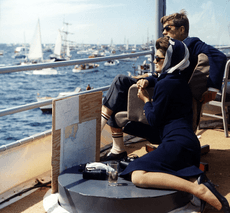
The J-class yachts from the 1930s remained the default for the cup, but post-war economic realities meant that no-one could afford to challenge in this hugely expensive class. As twenty years had passed since the last challenge, the NYYC looked for a cheaper alternative in order to restart interest in the cup. In 1956 Henry Sears led an effort to replace the J-class yachts with 12-metre class yachts, which are approximately 65 to 75 feet (20 to 23 m) in overall length.
The first post-war challenge was in 1958, again from the British. Briggs Cunningham, the inventor of the Cunningham sail control device, as skipper with Sears as navigator led Columbia to victory against Sceptre, which was designed by David Boyd at Alexander Robertson and Sons Ltd (Yachtbuilders), for a Royal Yacht Squadron Syndicate, chaired by Hugh Goodson.
The first Australian challenge was in 1962, when Gretel lost to the NYYC's Weatherly, designed by Philip Rhodes and helmed by Emil Mosbacher.
A second Boyd/Robertson challenger, Sovereign, lost to the Olin Stephens–designed Constellation in 1964. In 1967, another Australian challenger, Dame Pattie, lost to the innovative Olin Stephens design Intrepid, skippered again by Emil Mosbacher (which won again in 1970, to become the second yacht, after Columbia of 1899-1901, to defend the Cup twice).
For the 1970 America's Cup, interest in challenging was so high that the NYYC allowed the Challenger of Record (the original yacht club presenting the challenge accepted for the match) to organize a regatta among multiple challengers with the winner being substituted as challenger and going on to the cup match. This innovation has been used ever since, except for the default deed of gift matches in 1988 and 2010.
Alan Bond, an Australian businessman, made three unsuccessful challenges between 1974 and 1980. In 1974 the cup was successfully defended by Courageous, which successfully defended again in 1977, at which time she was skippered by Ted Turner. In 1980 the Cup was defended by Freedom.

Bond returned in 1983 for a fourth challenge, complete with a symbolic golden wrench which he claimed would be used to unbolt the cup from its plinth, so that he could take it back to Australia. In 1983 there were seven challengers for the cup competing for the inaugural Louis Vuitton Cup, the winner of which would go on to the America's Cup match against the NYYC's yacht selected in their trials. Bond's yacht, Australia II, designed by Ben Lexcen, skippered by John Bertrand, and representing the Royal Perth Yacht Club, easily won the Louis Vuitton challenger series, and Dennis Conner in Liberty was selected for the Cup defense.
Sporting the now famous Boxing Kangaroo flag and the controversial winged keel designed by Ben Lexcen, the hull of Australia II was kept under wraps between races and was subject to attempts by the NYYC to disqualify the boat. In the cup races, the Australians got off to a bad start with equipment failures and false starts giving the USA defenders a head start. But it was not to be a repeat of the last 132 years: the Australians came back and, despite a 3-1 deficit at the start of the fifth race, won the 1983 America's Cup 4–3 in a best-of-seven format. This was the first time the NYYC had lost the cup in 132 years and 26 challenges and opened the opportunity for other US Clubs to earn the trophy in future races. Alan Bond joked that the cup would be renamed "The Australia's Cup".
For the first time since its inception the America's Cup was defended outside of the US off the coast of Fremantle. This was a new era for the cup with interest in competing being shown by many countries.
Now representing his hometown San Diego Yacht Club, Conner returned to win the 1987 America's Cup. His yacht Stars & Stripes 87 earned the right to challenge by winning the 1987 Louis Vuitton Cup against an unprecedented field of 13 challenger syndicates. In the America's Cup regatta he faced defender Iain Murray sailing Kookaburra III, who had beaten Alan Bond's Australia IV in the defender selection trials. Stars & Stripes 87 swept Kookaburra III in four straight races for the title.
Technology was now playing an increasing role in yacht design. The 1983 winner, Australia II, had sported the revolutionary winged keel, and the New Zealand boat that Conner had beaten in the Louis Vuitton Cup final in Fremantle was the first 12-metre class to have a hull of fiberglass, rather than aluminum or wood.
The 12-metre class rules stipulated that the hull had to be the same thickness throughout and could not be made lighter in the bow and stern. The other challengers demanded that core samples be taken from the plastic hull to show its thickness. At one press conference Dennis Conner asked, "Why would you build a plastic yacht ... unless you wanted to cheat?" Despite attempts to defuse the situation, the "cheating comment" added to the controversy surrounding the Louis Vuitton challenge races. Chris Dickson, skipper of the Kiwi Magic (KZ 7), took the controversy in stride and with humour, and Conner has since stated his regret over his comment. New Zealand syndicate head Sir Michael Fay's comment was that core samples would be taken "over my dead body". Eventually some small holes were drilled to test the hull, and ultrasonic testing was done to rule out air pockets in the construction. The boat was found to be within class rules, and the issue was set aside. Fay ceremoniously lay down in front of the measurer before the samples were taken.
1988: The Mercury Bay Challenge
In 1987, soon after Conner had won back the cup with Stars and Stripes but before the San Diego Yacht Club had publicly issued terms for the next regatta, a New Zealand syndicate, again led by merchant banker Sir Michael Fay, lodged a surprise challenge. Fay challenged with a gigantic yacht named New Zealand (KZ1) or the Big Boat, which with a 90-foot (27 m) waterline, was the largest single masted yacht possible under the original rules of the cup trust deed. This was an unwelcome challenge to the San Diego Yacht Club, who wanted to continue to run Cup regattas using 12-metre yachts. A legal battle ensued over the challenge, with Justice Carmen Ciparick of the New York State Supreme (trial) Court (which administers the Deed of Gift) ruling that Fay's challenge on behalf of Mercury Bay Boating Club (MBBC) was valid. The court ordered SDYC to accept it and negotiate mutually agreeable terms for a match, or to race under the default provisions of the Deed, or to forfeit the cup to MBBC.
Forced to race, and lacking time for preparation, Conner and SDYC looked for a way to prevail. They recognized that a catamaran was not expressly prohibited under the rules. Multihulls, due to a lower wetted surface area and vastly lower mass, are inherently faster than equal-length monohulls. Conner, however, left nothing to chance and commissioned a cutting edge design with a wing sail, named—as his 12-metre yachts had been—Stars and Stripes.
The two yachts raced under the simple terms of the deed in September 1988. New Zealand predictably lost by a huge margin. Fay then took SDYC back to court, arguing that the race had been unfair, certainly not the "friendly competition between nations", envisaged in the Deed of Gift. Ciparick agreed and awarded New Zealand the Cup. However, Ciparick's decision was overturned on appeal and SDYC's win was reinstated. Fay then appealed to New York's highest court and lost. Thus SDYC successfully defended the cup in what observers described as the most controversial cup match to that point. (The 2010 America's Cup was a direct descendant of the 1988 cup, as it featured two gigantic multi-hull yachts and generated even more legal activity and controversy ).
1992–2007: The IACC rule
In the wake of the 1988 controversies, the International America's Cup Class (IACC) was introduced, replacing the 12-metre class that had been used since 1958.
In 1992, USA-23 of the America³ team, skippered by billionaire Bill Koch and Olympic medalist Harry “Buddy” Melges, defeated the Italian challenger Il Moro ITA-25, owned by billionaire Raul Gardini's Il Moro di Venezia, 4–1.
In 1995, the Royal New Zealand Yacht Squadron syndicate Team New Zealand, skippered by Russell Coutts, first won the challenger series in NZL 32, dubbed "Black Magic" because of her black hull and uncanny speed. Black Magic then easily swept Dennis Connor's Stars & Stripes team, in five straight races to win the title for New Zealand. Although team Young America's cup candidate yacht USA-36 was defeated in defender trials by Stars & Stripes' USA-34, the San Diego Yacht Club elected to defend the cup with USA-36 crewed by Stars & Stripes. The run-up to the 1995 Cup was notable for the televised sinking of oneAustralia during the fourth round robin of the Louis Vuitton challenger selection series, with all hands escaping uninjured. The 1995 defender selection series also had the first mostly female (with one man) crew sailing the yacht USA-43, nicknamed "Mighty Mary".
On 14 March 1996, a man entered the Royal New Zealand Yacht Squadron's clubroom and damaged the America's Cup with a sledgehammer. The man, Benjamin Peri Nathan, was charged and found guilty of criminal damage and sentenced to 34 months imprisonment (reduced to 18 months on appeal). The damage was so severe that it was feared that the cup was irreparable. London's Garrards silversmiths, who had manufactured the cup in 1848, painstakingly restored the trophy to its original condition over three months, free of charge. In 2003, an extra 20 cm was added to the cup's base to accommodate the names of future winners.
At Auckland in 1999–2000, Team New Zealand, led by Sir Peter Blake, and again skippered by Russell Coutts, defeated the Italian Prada Challenge from the Yacht Club Punta Ala. The Italians had previously beaten the AmericaOne syndicate from the St Francis Yacht Club in the Louis Vuitton Cup final. This was the first America's Cup to be contested without an American challenger or defender.
During the Twelve-Metre era, the New York Yacht Club, citing the Deed language that the Cup should be "perpetually a Challenge Cup for friendly competition between foreign countries", had adopted several interpretive resolutions intended to strengthen nationality requirements. By 1980, these resolutions specified that besides being constructed in the country of the challenger or defender, a yacht had to be designed by and crewed by nationals of the country where the yacht club was located. Globalization made it increasingly difficult to enforce design nationality rules, and starting in 1984, the Royal Perth Yacht Club began relaxing this requirement. Numerous members of the New Zealand AC 2000 team became key members of the Swiss 2003 Alinghi challenge, led by biotechnology entrepreneur Ernesto Bertarelli. To satisfy the crew nationality requirements, New Zealand team members of Alinghi took up residence in Switzerland.
In 2003, several strong challengers vied for the right to sail for the cup in Auckland during the challenger selection series. Bertarelli's team representing the Swiss yacht club, Société Nautique de Genève (SNG), beat all her rivals in the Louis Vuitton Cup and in turn won the America's Cup in a five-race sweep. In doing so, Alinghi became the first European team in 152 years of the event’s history to win the cup.
For the 2007 challenge, SNG rescinded all interpretive resolutions to the deed, essentially leaving "constructed in country" as the only remaining nationality requirement. The 2007 defense of the cup was held in Valencia, Spain. This was the first time since the original 1851 Isle of Wight race that the America's Cup regatta had been held in Europe, or in a country different from that of the defender (necessary because Switzerland, despite having huge lakes and a national passion for sailing, does not border a "sea or arm of the sea" as specified in the Deed). Eleven challenging yacht clubs from 9 countries submitted formal entries. The challenger selection series, the Louis Vuitton Cup 2007, ran from 16 April to 6 June 2007. Emirates Team New Zealand won the challenger series finale 5–0 against Italians Luna Rossa and met Alinghi between 23 June and 3 July 2007. Ernesto Bertarelli's Team- Alinghi successfully defended the America's Cup 5–2, under the colors of SNG.
2010: The Golden Gate Challenge
After Société Nautique de Genève successfully defended the trophy in the 32nd America's Cup, they accepted a challenge from Club Náutico Español de Vela, a Spanish yacht club formed expressly for the purpose of challenging for the cup and keeping the regatta in Valencia. When SNG and CNEV published their protocol for the 33rd America's Cup, there was criticism over its terms, with some teams and yacht clubs calling it the worst protocol in the history of the event. Golden Gate Yacht Club (GGYC) then filed its own challenge for the cup and also filed a court case asking that CNEV be removed as being unqualified under the deed of gift, and that GGYC be named the challenger, being the first club to file a conforming challenge.
There followed a long and acrimonious legal battle, with the New York Court of Appeals finally deciding on 2 April 2009 that CNEV did not qualify as valid challenger, and that the GGYC was thus the rightful challenger.
Since the two parties were unable to agree otherwise, the match took place as a one-on-one Deed of Gift match with no other clubs or teams participating.
The match was sailed in gigantic, specialized 90 ft (27 m) multihull yachts in a best-of-three race series in Valencia, Spain from 8 to 14 February 2010. The rigid wing sail of the challenging trimaran USA-17 provided a decisive advantage, and it won the 2010 America's Cup in two straight races.
2013–2017: The catamaran rules
The Challenger of Record for the 34th America's Cup was Club Nautico di Roma, whose team Mascalzone Latino had competed in the challenger selection series for the 2007 America's Cup. In September 2010, GGYC and Club Nautico di Roma announced the protocol for AC34, scheduling the match for 2013 in a new class of boat, the AC72, a wing-sailed catamaran. Paralleling the "Acts" of the 32nd America's Cup—a series of preliminary events in different venues leading-up to the actual event—a new series, the America's Cup World Series was to be run using AC45 class boats (smaller one-design versions of the AC72s), in various world venues in 2011 and 2012.
On 12 May 2011, Club Nautico di Roma withdrew from the competition, citing challenges in raising sufficient funds to field a competitive team. As the second yacht club to file a challenge, the Royal Swedish Yacht Club assumed the duties of the challenger.
Rumors of stable hydrofoiling of an AC72 were confirmed when Team New Zealand's AC72 yacht Aotearoa was seen to be sailing on hydrofoils in August 2012. This triggered a technology race in foil development and control. The Royal New Zealand Yacht Squadron won the right to sail in the America's Cup match easily beating the Italian and Swedish challengers in the Louis Vuitton Cup. The resulting match between the USA and NZ was the longest on record both in calendar time, and the number of races, with the Golden Gate Yacht Club staging an improbable come-from-behind victory, winning eight straight races to defend the cup and beat New Zealand 9–8.
Oracle Team USA was defending the America's Cup 26 May – 27 June 2017 on behalf of the Golden Gate Yacht Club in Bermuda where racing took place on the Great Sound. Preliminary races were held in Portsmouth, Gothenburg, and Bermuda in foiling AC45s. After the 2013 America's Cup, the Golden Gate Yacht Club accepted a notice of challenge from the Hamilton Island Yacht Club, with whom a new protocol and a smaller 62 ft (19 m) wingsail foiling catamaran class rule were proposed in cooperation with participating challengers. The Hamilton Island Yacht Club withdrew from the America's Cup in July 2014, citing unanticipated cost in mounting its challenge.
The exiting challenger of record was replaced by a challenger committee, where decisions are made by popular vote. When an even smaller 50ft wingsail foiling catamaran class rule amendment was voted in April 2015, Luna Rossa Challenge also withdrew, citing significant costs wasted on the development of the larger vessel. Yachts from France, Japan, New Zealand, Sweden, and the UK remained in the competition to challenge for the cup. In June 2016, for the first time in history, an America's Cup race included fresh water sailing, when preliminary races were held on Lake Michigan and based in Chicago, Illinois. Emirates Team New Zealand won the 2017 Louis Vuitton Cup and then challenged the defender, Oracle Team USA. New Zealand won the America's Cup with a score of 7 to 1.
2021 America's Cup
The next America's Cup will see the Royal New Zealand Yacht Squadron defend the cup. The Challenger of Record is Circolo della Vela Sicilia who will be represented by their team Luna Rossa Challenge. The event will be held in the southern summer, in the early part of 2021. The series will be contested in the AC75 class monohulls.
Challengers and defenders
| Rule | Year | Venue | Defending club | Defender | Score | Challenger | Challenging club |
|---|---|---|---|---|---|---|---|
| Fleet racing | |||||||
| 1851 | Isle of Wight | 8 cutters and 7 schooners, runner-up Aurora | 0–1 | John Cox Stevens syndicate, America | |||
| 1870 | New York City | 17 schooners, winner Franklin Osgood's Magic | 1–0 | James Lloyd Ashbury, Cambria | |||
| Schooner match |
|||||||
| 1871 | New York City | Franklin Osgood, Columbia (2–1) and William Proctor Douglas, Sappho (2–0) |
4–1 | James Lloyd Ashbury, Livonia | |||
| 1876 | New York City | John Stiles Dickerson, Madeleine | 2–0 | Charles Gifford, Countess of Dufferin | |||
| 65 ft sloop | |||||||
| 1881 | New York City | Joseph Richard Busk, Mischief | 2–0 | Alexander Cuthbert, Atalanta | |||
| NYYC 85ft | |||||||
| 1885 | New York City | John Malcolm Forbes syndicate, Puritan | 2–0 | Sir Richard Sutton, Genesta | |||
| 1886 | New York City | Charles Jackson Paine, Mayflower | 2–0 | Lt. & Mrs. William Henn, Galatea | |||
| 1887 | New York City | Charles Jackson Paine, Volunteer | 2–0 | James Bell syndicate, Thistle | |||
| SCYC 85ft | |||||||
| 1893 | New York City | Charles Oliver Iselin syndicate, Vigilant | 3–0 | Earl of Dunraven, Valkyrie II | |||
| SCYC 90ft | |||||||
| 1895 | New York City | William K. Vanderbilt syndicate, Defender | 3–0 | Earl of Dunraven syndicate, Valkyrie III | |||
| 1899 | New York City | J. Pierpont Morgan syndicate, Columbia | 3–0 | Sir Thomas Lipton, Shamrock | |||
| 1901 | New York City | J. Pierpont Morgan syndicate, Columbia | 3–0 | Sir Thomas Lipton, Shamrock II | |||
| 1903 | New York City | Cornelius Vanderbilt III syndicate, Reliance | 3–0 | Sir Thomas Lipton, Shamrock III | |||
| Universal 75 ft | |||||||
| 1920 | New York City | Henry Walters syndicate, Resolute | 3–2 | Sir Thomas Lipton, Shamrock IV | |||
| Universal J-Class |
|||||||
| 1930 | Newport | Harold S. Vanderbilt syndicate, Enterprise | 4–0 | Sir Thomas Lipton, Shamrock V | |||
| 1934 | Newport | Harold S. Vanderbilt syndicate, Rainbow | 4–2 | Sir Thomas Sopwith, Endeavour | |||
| 1937 | Newport | Harold S. Vanderbilt, Ranger | 4–0 | Sir Thomas Sopwith, Endeavour II | |||
| IYRU 12mR | |||||||
| 1958 | Newport | Henry Sears, Columbia | 4–0 | Hugh Goodson syndicate, Sceptre | |||
| 1962 | Newport | Mercer, Walsh, Frese syndicate, Weatherly | 4–1 | Sir Frank Packer, Gretel | |||
| 1964 | Newport | Eric Ridder syndicate, Constellation | 4–0 | Anthony Boyden, Sovereign | |||
| 1967 | Newport | William Justice Strawbridge syndicate, Intrepid | 4–0 | Emil Christensen, Dame Pattie | |||
| 1970 | Newport | William Justice Strawbridge syndicate, Intrepid | 4–1 | Sir Frank Packer, Gretel II | |||
| 1974 | Newport | Robert Willis McCullough syndicate, Courageous | 4–0 | Alan Bond, Southern Cross | |||
| 1977 | Newport | Ted Turner, Courageous | 4–0 | Alan Bond, Australia | |||
| 1980 | Newport | Freedom syndicate, Freedom | 4–1 | Alan Bond, Australia | |||
| 1983 | Newport | Freedom syndicate, Liberty | 3–4 | Alan Bond, Australia II | |||
| 1987 | Fremantle | Kevin Parry, Kookaburra III | 0–4 | Sail America, Stars & Stripes 87 | |||
| DOG match | 1988 | San Diego | Sail America, Stars & Stripes 88 | 2–0 | Fay Richwhite, KZ-1 | ||
| IACC | |||||||
| 1992 | San Diego | Bill Koch, America3 | 4–1 | Raul Gardini, Il Moro di Venezia | |||
| 1995 | San Diego | Sail America, Young America | 0–5 | Team New Zealand, NZL-32/Black Magic | |||
| 2000 | Auckland | Team New Zealand, NZL-60 | 5–0 | Prada Challenge, Luna Rossa | |||
| 2003 | Auckland | Team New Zealand, NZL 82 | 0–5 | Alinghi, SUI-64 | |||
| 2007 | Valencia | Alinghi, SUI-100 | 5–2 | Team New Zealand, NZL-92 | |||
| DOG match | 2010 | Valencia | Alinghi, Alinghi 5 | 0–2 | BMW Oracle Racing, USA-17 | ||
| AC72 | 2013 | San Francisco | Oracle Team USA, Oracle Team USA 17 | 9–8 | Team New Zealand, Aotearoa | ||
| AC50 | 2017 | Bermuda | Oracle Team USA, 17 | 1–7 | Team New Zealand, Aotearoa | ||
| AC75 | 2021 | Auckland | Emirates Team New Zealand | Luna Rossa Challenge, Luna Rossa |
Records of winning clubs and skippers
![]() New York Yacht Club: 25–1
New York Yacht Club: 25–1
![]() Royal New Zealand Yacht Squadron: 3–3
Royal New Zealand Yacht Squadron: 3–3
![]() San Diego Yacht Club: 3–1
San Diego Yacht Club: 3–1
![]() Société Nautique de Genève: 2–1
Société Nautique de Genève: 2–1
![]() Golden Gate Yacht Club: 2–1
Golden Gate Yacht Club: 2–1
![]() Royal Perth Yacht Club: 1–3
Royal Perth Yacht Club: 1–3
![]() Charlie Barr - Wins 1899, 1901, 1903 - Won 9 / Loss 0
Charlie Barr - Wins 1899, 1901, 1903 - Won 9 / Loss 0
![]() Harold S. Vanderbilt - Wins 1930, 1934, 1937 - Won 12 / Loss 2
Harold S. Vanderbilt - Wins 1930, 1934, 1937 - Won 12 / Loss 2
![]() Dennis Conner - Wins 1980, 1987, 1988 - Won 13 / Loss 5
Dennis Conner - Wins 1980, 1987, 1988 - Won 13 / Loss 5
![]() Russell Coutts - Wins 1995, 2000, 2003 - Won 14 / Loss 0
Russell Coutts - Wins 1995, 2000, 2003 - Won 14 / Loss 0
![]() Jimmy Spithill - Wins 2010, 2013 - Won 13 / Loss 8
Jimmy Spithill - Wins 2010, 2013 - Won 13 / Loss 8
In the media
In 1928, Goodyear chairman Paul W. Litchfield began a tradition of naming the company's blimps after America's Cup yachts, including America, Puritan, Mayflower, Volunteer, Vigilant, Defender, Reliance, Resolute, Enterprise, Rainbow, Ranger, Columbia and Stars & Stripes.
The 1992 film Wind is largely about the America's Cup racing towards the end of the 12-meter era. Although the names have been changed, it is largely about Dennis Conner's 1980s cycle of loss and comeback.
Images for kids
See also
 In Spanish: Copa América (Vela) para niños
In Spanish: Copa América (Vela) para niños


